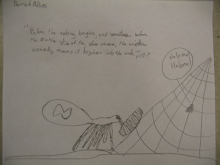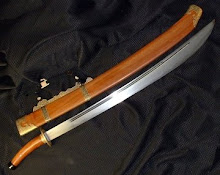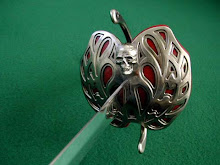Top Three Melee Weapons
The criteria for my choices are blade design, defensive opportunities, reach, and wounding capabilities. Blade design means the blade of the weapon is suitable for its offensive style; Defensive opportunity means the weapons flexibility and durability in the face of an opponent’s attack. Reach means the length of the blade and its ability to wound at a longer distance and wounding capabilities means the severity of the damage caused by a regular attack. In addition to the basic requirements, the overall looks of the weapon and the skill necessary to wield it will be taken into account.
# 3: Chinese Broadsword
The Chinese broadsword is a difficult to master curved weapon often used by Shaolin Monks in their ancient monasteries in northwestern China. The hilt often has a red cloth attached to it, near the pommel, and rings are often punched through the back edge. Both of these modifications were invented by the Shaolin monks to give their opponent’s some indication as to when the blade was coming. The Shaolin were know to be astonishingly fast with their weapons and were famous mercenaries in ancient China. The Blade is made primarily for slashing and hacking motions, which the Shaolin execute with unbelievable speed. The Blade is very rigid to add power to the cuts and, as such, would shatter easily if hit hard with a heavy weapon. The blade itself isn’t very long, as the Shaolin fighting style works very close to the body and a long blade would injure its wielder. The Shaolin make up for this with their blinding speed and agility, but an average swordsman may find this to make things more complicated. The weapon itself lacks and real weight to cause a severely damaging wound with a simple cut, but the agility of the weapon make large numbers of attacks in a short period of time possible. The weaknesses of the blade in the hands of anyone but a Shaolin monk combined with its natural strengths make this my third favorite melee weapon.
# 2: Rapier
Rapiers are long, narrow thrusting swords common in the renaissance period. They evolved slowly during the late middle ages as gunpowder made armor more and more useless. The name “Rapier” comes from the Spanish word, espada ropera, which means “Dress sword.” There is over fifty known styles of rapier, whose manuals still exist in modern times. The rapier is the ancestor of the modern epee and foil used in Olympic fencing. The very long blade tapers to a very fine point, sharp enough to pierce through 2 inches of armor grade steel without using a lot of force. The blade itself is very narrow, making a direct block almost pointless. However, the flexibility of the blade makes using the guard to turn an opponent’s blade while retaliating, called a riposte, very easy. Modern movie sword fighting is loosely based on the look of to good fencers going at it, parrying and reposting, then blocking the opponent’s parry and riposte. The reach of the blade is huge, often at 48 inches of blade past the guard. This is approximately the length of a two handed longsword’s blade, although the rapier weighs several pounds less. The offensive capabilities of a rapier are mostly limited to thrusting, although cuts can be somewhat effective. Another thing about the rapier is the guard can be nothing more than a steel bowl covering the hilt all the way to a gilt tangle of high grade steel bars made to resemble a face. The looks of a rapier, its speed and agility, and the fact that I am trained in a late renaissance period style of fencing created by Maestro Rodolfo Cappo Ferro of Italy, who is considered to be the Grandfather of modern fencing, make this my second favorite melee weapon.
# 1: The Broadsword
The Broadsword is an ancient and venerated weapon whose earliest forms were among the first sword designs created by humans. Some form of the straight, broad bladed weapon can be found in almost every culture in the world. The Romans created the first uniformly similar broadsword in the gladius, the sidearm of Rome’s elite infantry, the legionnaires. The weapon further evolved during the middle ages after the fall of Rome, during the first invasions by the Angles, the Saxons and the Jutes. These three groups brought their own versions of the broadsword, which the Celts defending Briton combined with the design of the Gladius, giving the weapon a longer and heavier blade with a pointed tip for thrusting. This is the basis for the broadswords wielded by the knights of the middle ages. The Scots worked further on this design, refining the design and adding a basket to the hilt to protect the wielders hand from attacks. The blade is heavy and well suited to chopping and hacking attacks although lighter blades were known. The blade maintains a decent level of flexibility on designs made after the discovery of steel, and has the blade strength to take many heavy hits without too much damage. The length of the broadsword varies according to design, but seldom goes longer than 38 inches, and that rarely. The wounding power of the broadsword is almost unmatched among one handed swords. These factors combine to make the broadsword my favorite melee weapon.
Subscribe to:
Post Comments (Atom)












No comments:
Post a Comment